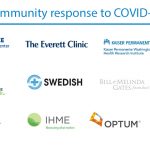Incident Command: A Team of Teams Coming Together to Respond to COVID-19
“In crisis management, you’re focused on the objectives that need to be completed in a 24-hour period of time to keep people safe,” says Betty Chu, MD, incident commander for the COVID-19 response operations of Henry Ford Health System (HFHS). Chu is senior vice-president, associate chief clinical officer, and chief quality officer for HFHS, a CAPP member group. When the novel coronavirus outbreak in China was first known, Chu and her team started a planning process to determine how HFHS should respond if and when the virus arrived in her state of Michigan.
Disaster preparedness has become an integral part of health systems operations. While a pandemic may have been viewed as less likely than outbreaks of wildfires, hurricanes, or mass casualty events from shootings or accidents, the infrastructure and teams that organized health systems have put in place are serving them well during the COVID-19 pandemic. Incident command centers are key to assembling a response “team of teams” within these organizations. To be effective, the command centers must have reliable IT capacity and operational systems in place to communicate and track availability of staff, supplies, and equipment. Security measures and mobile devices are critical to enable the command to operate virtually — as many must do in the current pandemic.
Building the Plane While Flying It
Incident commands must plan ahead for various phases of the response, while responding in real time to current demands. Unlike most other disease outbreaks or accidents, the novel coronavirus has no evidence-based therapeutics, and almost no literature to inform clinical protocols or guidelines for appropriate personal protective equipment (PPE).
For CAPP member Northwell Health, operating New York’s largest health system with 23 hospitals spanning all of Long Island as well as hospitals within New York City, there was not a lot of time to prepare for the surge of patients sick with COVID-19 who would turn to Northwell for care. Northwell’s Chief Quality Officer, Mark Jarrett, MD, shared their real-time experience in a webinar hosted by the Patient Centered Outcomes Research Institute. Dr. Jarrett notes that Northwell incident command has taken a “plan for the worst” approach.
The Northwell incident command team has had to work remotely, assembling and analyzing an enormous amount of data to determine how many ventilators are likely to be needed, and what ICU staffing ratios were feasible in the face of staff shortages and measures needed to protect staff. The incident command identified ambulatory sites to take care of patients and explored the rental of space in nursing homes for discharged patients. They assessed strategies for extending the life of N95 respirators, and repurposing anesthesia machines as ventilators. The incident command process also saw the need to repurpose mobile devices such as cameras, tablets, and monitors to be used to help isolated patients speak with loved ones, and to monitor patients while minimizing staff entry and exit in isolation rooms.
Each Northwell hospital has its own surge plans based on predictive modeling for its geography. Other decisions made by the Northwell incident command include updating testing criteria, managing non-COVID patients at home, while communicating that Northwell was still open for cardiac emergencies. Some emergency surgeries cannot be deferred, so a small committee determines how each such case is handled. Looking ahead, Dr. Jarrett planned for emergency credentialing and bringing clinicians out of retirement to supplement the workforce and alleviate the enormous stress on the workforce.
Like the New York City metro area, the Detroit metro region became a hotspot in early April. By late March, Henry Ford Health System had developed multi-phase surge capacity, converting inpatient and outpatient space for non-COVID patients and readied these units to accept COVID-19 transfers from nearby Henry Ford Hospital. It designated its Level 1 trauma hospital to care for the most COVID-19 patients. The system also converted community hospital operating rooms into intensive care beds to expand its ICU capacity. Non-COVID-19 related procedures that cannot be postponed are being performed on a limited basis in one hospital.
Leveraging the incident command process, Henry Ford provided additional training to staff on proper use of PPE, secured adequate supplies of PPE, and recommended infection prevention precautions. Employees are screened for the virus as they report to work, and their access points to all sites of care are limited. “I can’t say enough about the extraordinary work of our providers, nurses and team members who have rallied around these action steps and brought them to fruition,” says incident commander Dr. Chu.
“While we can’t predict what’s to come, we believe the steps we’ve taken put us in a better position to manage the care of our patients.” — incident commander Dr. Chu
Incident command is not limited to big metropolitan hospital systems. CAPP member Marshfield Clinic has sprawling inpatient and ambulatory operations throughout rural and small-town Wisconsin. The health care workforce is an especially scarce resource in rural areas. Marshfield Clinic is participating in joint incident command calls with Ascension, another health system with operations in Wisconsin, to coordinate surge planning. Marshfield and Ascension have developed shared employee agreements to support each other and allow Ascension to increase patient care capacity at two facilities. Marshfield Clinic physicians can now provide additional inpatient and emergency coverage.
To quote General Stanley McCrystal, incident commands are “a team of teams” that come together to plan, rehearse, and respond to emergencies and disasters. Medical groups, such as those in CAPP who have incorporated strong, flexible multidisciplinary teams into their cultural DNA, have seamlessly mobilized their incident command structure to meet the COVID-19 moment.





